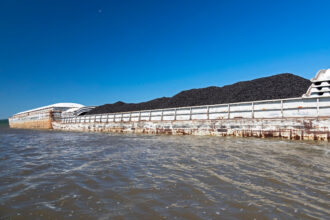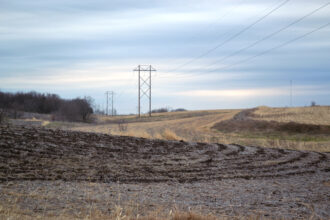CHICAGO—The state of Illinois will decide by the end of this year whether to allow a natural gas utility in Chicago to raise its rate next year by $402 million. At a public hearing on Tuesday, leaders from the company, Peoples Gas, listened to comments from ratepayers about the proposition to increase rates to offset the cost of replacing corroding pipes across the city.
The request to fund the project to continue to replace 2,000 miles of gas pipes comes as the City of Chicago and Illinois take steps to transition away from fossil fuels and a third of Peoples Gas customers are behind on their gas bills.
Leaders of Peoples Gas started the public hearing on Tuesday by outlining their reasons for raising customers’ bills next year, standing behind a display of a yellow plastic pipe and a thick piece of metal pipe.
“Pipes that run beneath many of the Chicago streets in every single neighborhood carrying the natural gas you need to heat your home and rely on are unfortunately at the very end of their useful life and, in fact, are among the oldest pipes in our nation,” said Torrence Hinton, president of Peoples Gas.
Four years ago, Peoples Gas pulled one that was installed before the start of the Civil War, he said. The company started replacing pipes over a decade ago, according to the company website. A 2019 report by the Illinois Public Interest Research Group found that the total cost of the pipe replacement program could be as much as $11 billion, based on the company’s rate of investment so far.
Tom Aridas, Peoples Gas director of regulatory policy and local government affairs, said replacing the pipes is a matter of safety and reliance, as an independent study showed that over 80 percent of the iron pipes in the system are nearing the end of their useful life.
The utility serves more than 884,000 customers in Chicago, according to its website.
Already, some of the original pipes are leaking, Hinton said. If the pipes fail, methane could contaminate the air, soil and water, threatening the health of nearby residents. He claimed new pipes would be safer and environmentally sustainable in the long term because it would reduce the risk of failures.
David Schwartz, spokesperson for Peoples Gas, said the company’s infrastructure improvements have reduced methane emissions by more than 1,300 metric tons since 2017.
“Our research and investments in emerging clean energy technologies—including renewable natural gas and hydrogen—will help Illinois meet its climate goals as part of an energy future that is reliable, environmentally sustainable and affordable,” Schwartz said in an email to Inside Climate News.
But critics at the forum said the continued effort to install new pipelines contradicts Chicago’s and Illinois’’ climate goals and their commitment to safety, given research showing that natural gas delivered to homes contains low levels of chemicals linked to cancer and asthma.
“Folks are facing poor outdoor air quality and then going home to poor indoor air quality from fossil fuel infrastructure,” said Courtney Hanson, deputy director at People for Community Recovery, an environmental justice organization based in the far South Side. “That’s not only making them sick; it’s contributing to really high energy burdens.”
This story is funded by readers like you.
Our nonprofit newsroom provides award-winning climate coverage free of charge and advertising. We rely on donations from readers like you to keep going. Please donate now to support our work.
Donate NowTwo years ago, Illinois set a goal to reach 100 percent renewable energy by 2050. Its Climate and Equitable Jobs Act requires zero emissions from natural gas by 2045.
The City of Chicago set a goal to use all renewable energy to power buildings community-wide by 2035. “Aggressively accelerating energy efficiency in new and existing buildings, along with rapid building electrification, is needed to achieve the ambitious goals set in the 2022” Climate Action Plan, the plan states.
Last month, the new mayor of Chicago, Brandon Johnson, received a transition blueprint for addressing some of the city’s most critical issues. The transition report highlighted the need for a plan to decarbonize buildings, including goals requiring new buildings to be all-electric starting in 2025 and developing policies that address indoor air pollution by transitioning away from fossil fuel heating, cooling and cooking.
Additionally, the city announced a $15 million commitment to decarbonize buildings, funding organizations to upgrade up to 350 homes by 2025. The initiative would build on efforts by former mayor Lori Lightfoot, who convened a working group that released recommendations for guiding building decarbonization, targeting underserved communities with electrification and energy efficiency projects, Energy News Network reported. Under her administration, the city approved a $188 million allocation in the city’s 2022 budget toward climate and environmental projects, including building decarbonization.
Schwartz from Peoples Gas said very few people can afford to retrofit their homes with all-electric technology and that the company sees “a future where a diverse mix of energies and technologies heats and powers Chicago.”
Members of a local gas workers union supported the rate increase, saying it is necessary to make the pipes safe and that the company’s projects bring job opportunities.
While several opponents acknowledged the importance of making the pipes safe, some argued that the funds for the pipe replacements shouldn’t come out of customers’ pockets, especially as the company continues to see record profits for the sixth year in a row.
The increase would add an average of almost $12 to customers’ monthly bills.
“This is not affordable for folks like me,” said Scott Onque, a pastor at St. Luke Missionary Baptist Church in the South Side. “This could be the difference of eating or getting to work in that month. We want a future with renewable energy and houses that do not slowly kill us.”
An analysis by the Chicago Sun-Times found that about a third of all Peoples Gas customers are behind on gas bills and that most live in Black- and brown-majority ZIP codes, concentrated in the city’s South Side and West Side. Illinois had the highest number of gas utility shutoffs nationwide last year, a 164 percent increase from the prior year, according to a January analysis by the Center for Biological Diversity.
Emma Fisher, a Peoples Gas customer in the North Side neighborhood of Rogers Park, told officials at the hearing that the rates are “absurd” and said the investments will become “stranded assets” that lose economic value ahead of their anticipated useful life as the transition to renewables takes hold.
“Even consumers like myself working to reduce gas usage for environmental and or budget reasons are stuck paying high fixed charges, so to me, this is really about responsible long-term planning in the face of the clean energy transition,” said Fisher.
Aridas from Peoples Gas said they expect the rate increase to be offset by a decline in the market price of natural gas by next year and by the expiration of a $15 surcharge customers have been paying for a decade each month.
The Illinois Commerce Commission is expected to decide by December of this year. If approved, the new rates would apply starting in 2024.
About This Story
Perhaps you noticed: This story, like all the news we publish, is free to read. That’s because Inside Climate News is a 501c3 nonprofit organization. We do not charge a subscription fee, lock our news behind a paywall, or clutter our website with ads. We make our news on climate and the environment freely available to you and anyone who wants it.
That’s not all. We also share our news for free with scores of other media organizations around the country. Many of them can’t afford to do environmental journalism of their own. We’ve built bureaus from coast to coast to report local stories, collaborate with local newsrooms and co-publish articles so that this vital work is shared as widely as possible.
Two of us launched ICN in 2007. Six years later we earned a Pulitzer Prize for National Reporting, and now we run the oldest and largest dedicated climate newsroom in the nation. We tell the story in all its complexity. We hold polluters accountable. We expose environmental injustice. We debunk misinformation. We scrutinize solutions and inspire action.
Donations from readers like you fund every aspect of what we do. If you don’t already, will you support our ongoing work, our reporting on the biggest crisis facing our planet, and help us reach even more readers in more places?
Please take a moment to make a tax-deductible donation. Every one of them makes a difference.
Thank you,













